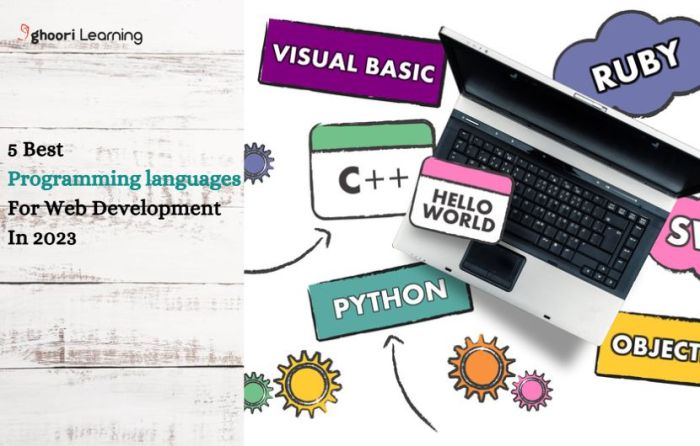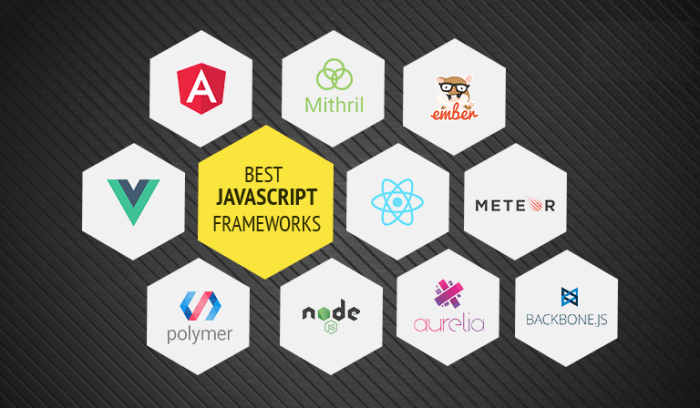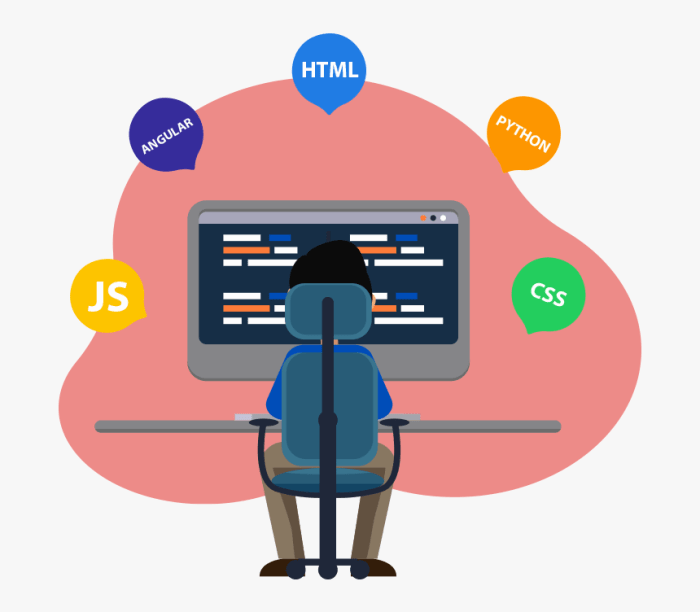
Step into the world of Web development programming tutorials, where coding becomes an adventure filled with creativity and innovation. Get ready to unlock the secrets of web development and unleash your coding potential!
From understanding the basics to exploring advanced concepts, this guide will take you on a journey through the realm of programming languages and development tools, ensuring you’re equipped to thrive in the digital landscape.
Introduction to Web Development Programming Tutorials

Web development programming tutorials play a crucial role in helping individuals learn how to create websites and web applications. These tutorials provide step-by-step guidance, practical examples, and hands-on experience to aspiring developers.
Types of Programming Languages in Web Development Tutorials
There are several programming languages commonly used in web development tutorials, each serving different purposes and functionalities:
- HTML: Used for creating the structure of web pages.
- CSS: Responsible for styling and design of web pages.
- JavaScript: Enables interactive elements and dynamic content on websites.
- PHP: Used for server-side scripting and backend development.
- Python: Popular for web development frameworks like Django and Flask.
Popular Platforms for Web Development Programming Tutorials
There are numerous platforms and websites offering web development programming tutorials to help individuals enhance their skills and knowledge. Some popular options include:
- W3Schools : Offers comprehensive tutorials on web development technologies.
- Codecademy : Provides interactive coding lessons for beginners and advanced developers.
- MDN Web Docs : Offers detailed documentation and tutorials on web technologies.
Basics of Web Development Programming

Web development programming involves creating websites and web applications using coding languages such as HTML, CSS, and JavaScript. It focuses on the design, development, and maintenance of websites to ensure they function correctly and provide an optimal user experience.
Fundamental Concepts
- HTML (Hypertext Markup Language): Used to create the structure and content of web pages.
- CSS (Cascading Style Sheets): Controls the layout and appearance of web pages, including fonts, colors, and spacing.
- JavaScript: Adds interactivity to websites by allowing dynamic content, animations, and user interactions.
- Responsive Design: Ensures websites adapt to different screen sizes and devices for a seamless user experience.
Simple Coding Exercises
- Create a basic HTML webpage with headings, paragraphs, and images.
- Style the webpage using CSS to change colors, fonts, and layout.
- Add a simple JavaScript function to display an alert message or change content dynamically.
Advanced Concepts in Web Development Programming
In the world of web development programming, there are several advanced concepts that developers must understand to create sophisticated and dynamic websites. These concepts go beyond the basics and delve into more complex topics that require a deeper level of knowledge and expertise.
Server-side vs. Client-side Programming
Server-side programming involves writing code that runs on the server and generates the HTML, CSS, and JavaScript that is sent to the client’s browser. This type of programming is often used for tasks that require accessing databases, processing forms, and managing user sessions. On the other hand, client-side programming involves writing code that runs in the user’s browser and interacts with the user interface.
This type of programming is commonly used for creating interactive elements, animations, and dynamic content without requiring the server to reload the entire page.
- Server-side programming:
- Client-side programming:
Uses languages like PHP, Python, Ruby, and Java.
Allows for secure data processing and manipulation.
Requires server resources to execute code.
Uses languages like JavaScript, HTML, and CSS.
Enhances user experience with dynamic content.
Reduces server load by offloading tasks to the client’s browser.
Importance of Responsive Design
Responsive design is a crucial concept in modern web development that ensures websites adapt to different screen sizes and devices, providing an optimal viewing experience for users. With the increasing use of smartphones and tablets, it is essential for websites to be responsive to deliver a seamless user experience across all devices.
- Benefits of responsive design:
Improves user experience by ensuring content is easily accessible on any device.
Enhances performance by having a single URL for all devices.
Increases conversion rates and reduces bounce rates.
Tools and Technologies for Web Development
When it comes to web development programming, having the right tools and technologies at your disposal can make a significant difference in your workflow and the quality of your projects. Let’s explore some essential tools and software commonly used in web development, along with the role of version control systems like Git.
Integrated Development Environments (IDEs)
Integrated Development Environments (IDEs) are software applications that provide comprehensive tools for web developers to write, test, and debug their code efficiently. Some popular IDEs for web development include:
- Visual Studio Code: A lightweight yet powerful IDE with a wide range of extensions and support for various programming languages.
- Sublime Text: Known for its speed and simplicity, Sublime Text offers a customizable interface and powerful features for coding.
- Atom: Developed by GitHub, Atom is a highly customizable IDE that allows developers to collaborate and integrate with Git seamlessly.
Version Control Systems like Git
Version control systems like Git play a crucial role in web development projects by allowing developers to track changes in their code, collaborate with team members, and revert to previous versions if needed. Key features of Git include:
- Branching: Developers can work on different features or fixes simultaneously by creating branches in Git.
- Merging: Git enables developers to merge changes from different branches while resolving any conflicts that may arise.
- Remote Repositories: With Git, developers can push their code to remote repositories like GitHub or Bitbucket for backup and collaboration purposes.
By leveraging the right tools and technologies, web developers can streamline their workflow, collaborate effectively, and deliver high-quality projects efficiently.
Specialized Areas in Web Development
Front-end Development Techniques:Front-end development focuses on the visual and interactive aspects of a website or web application. It involves using languages like HTML, CSS, and JavaScript to create user-friendly interfaces. Tutorials on front-end development often cover topics such as responsive design, user experience (UX) design, and front-end frameworks like Bootstrap and React.
Back-end Development Tutorials and Significance
Back-end Development:Back-end development involves working on the server-side of web development. This includes managing databases, user authentication, and server communication. Tutorials on back-end development often delve into languages like PHP, Python, and Ruby, as well as frameworks like Node.js and Django. Understanding back-end development is crucial for creating dynamic and functional web applications.
Basics of Full-stack Development and Tutorials
Full-stack Development:Full-stack development combines both front-end and back-end development skills. A full-stack developer is proficient in working on the entire web development process, from designing user interfaces to managing databases and server-side logic. Tutorials on full-stack development cover a wide range of topics, including working with databases, API integration, and deployment strategies. Learning full-stack development allows developers to have a comprehensive understanding of web development and the ability to work on all aspects of a project.
Trends and Updates in Web Development Programming
In the fast-paced world of web development programming, staying updated with the latest trends and technologies is crucial to remain competitive and relevant in the industry. Let’s explore some of the key trends shaping the landscape of web development tutorials today.
Rise of Progressive Web Apps (PWAs)
Progressive Web Apps have gained significant popularity due to their ability to provide a seamless user experience across various devices. These apps combine the best features of web and mobile applications, offering fast loading times, offline functionality, and push notifications. Web development tutorials now focus on creating PWAs to enhance user engagement and accessibility.
Integration of Artificial Intelligence (AI) and Machine Learning
AI and Machine Learning technologies are revolutionizing web development by enabling developers to create more personalized and intelligent user experiences. Tutorials now cover how to integrate AI-powered chatbots, recommendation systems, and predictive analytics into websites to enhance user interaction and drive conversions.
Emphasis on Responsive Design and Accessibility
With the increasing use of mobile devices and different screen sizes, responsive design has become a standard practice in web development tutorials. Developers are now focusing on creating websites that adapt seamlessly to various devices and ensure accessibility for users with disabilities. Tutorials emphasize the importance of responsive design and accessibility standards to reach a wider audience.
Adoption of Serverless Architecture
Serverless architecture has emerged as a cost-effective and scalable solution for web development projects. By eliminating the need to manage servers, developers can focus on writing code and deploying applications quickly. Web development tutorials now cover how to leverage serverless platforms like AWS Lambda and Azure Functions to build efficient and scalable web applications.
Impact of JavaScript Frameworks like React, Angular, and Vue
JavaScript frameworks like React, Angular, and Vue have revolutionized the way web applications are built. These frameworks offer powerful tools for building interactive user interfaces, managing state, and optimizing performance. Web development tutorials now focus on teaching developers how to use these frameworks effectively to create dynamic and responsive web applications.
Computers Programming
Computer programming involves writing, testing, and maintaining the source code of computer programs. It is the process of creating instructions that a computer can execute to perform specific tasks.
Programming Languages
- Java: A popular object-oriented programming language used for developing desktop, web, and mobile applications.
- Python: Known for its simplicity and readability, Python is widely used in web development, data science, and automation.
- C++: A powerful language often used for system software, game development, and high-performance applications.
- JavaScript: Essential for web development, JavaScript enables interactive elements on websites and web applications.
- SQL: Specifically designed for managing and querying databases, SQL is crucial for storing and retrieving data efficiently.
Algorithms and Data Structures
Algorithms are step-by-step procedures or formulas for solving problems. They are essential in computer programming as they define the logical flow of a program and determine its efficiency. Data structures, on the other hand, organize and store data in a computer so that it can be accessed and manipulated efficiently.
Understanding algorithms and data structures is fundamental for writing efficient and scalable code.
Epilogue
As you wrap up your exploration of Web development programming tutorials, remember that coding is not just about syntax—it’s about problem-solving, creativity, and continuous learning. Embrace the challenges, stay curious, and keep coding!
Popular Questions
What are the benefits of learning web development programming?
Learning web development programming opens up endless opportunities for creating websites, applications, and software, allowing you to bring your ideas to life in the digital world.
Which programming languages are commonly used in web development tutorials?
Popular languages include HTML, CSS, JavaScript, Python, and more, each serving a unique purpose in web development projects.
Why is responsive design important in modern web development?
Responsive design ensures that websites adapt to different devices and screen sizes, providing a seamless user experience across desktops, tablets, and mobile devices.



